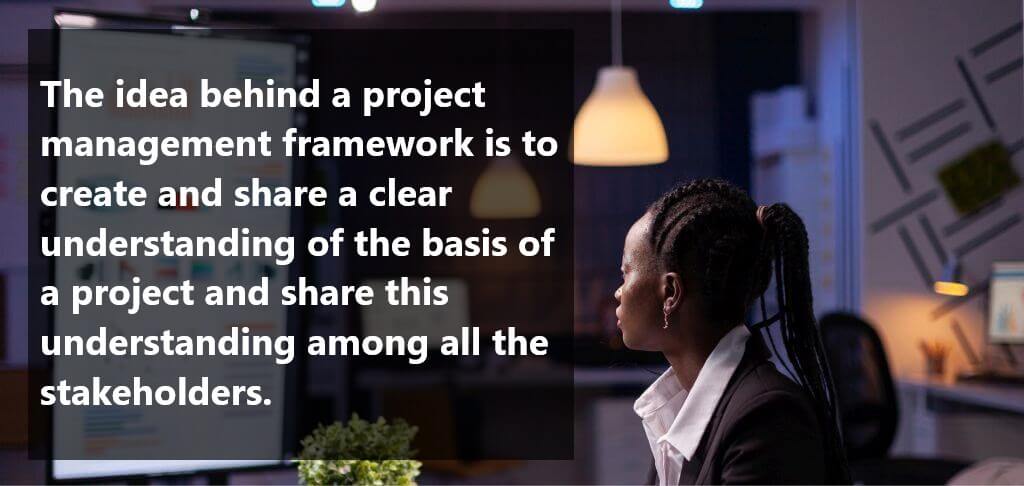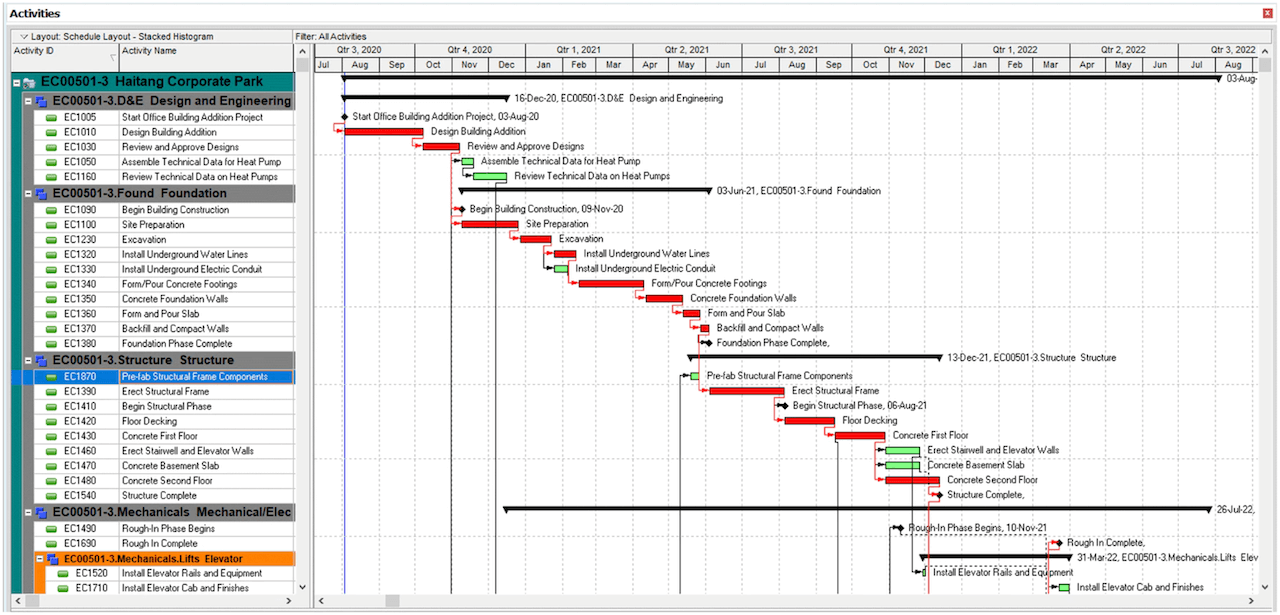
Simply defined, a project management framework (PMF) is an overall systematic approach for managing resources, tools, and processes needed to move a given project through its life cycle. This framework defines the steps needed to plan, initiate, execute, control, and close a project.
This article will examine the essential components of PMFs, their role in project management, and the various methodologies that refer to project frameworks
For senior managers, PMFs serve as the fundamental building blocks of project management methodologies. They formalize and provide structure to the work processes of projects and define the relationships between the project team, the project sponsor, and other project stakeholders.
What is a Project Management Framework (PMF)?
A project management framework (PMF) is a set of well-defined and structured guidelines to plan, organize, control and terminate the development of a given project. The main objective of this framework is to provide the project stakeholders with a set of standards and guidelines as to how to deal with any complexities of the project in any given situation
The idea behind a project framework is to create and share a clear understanding of the basis of a project and share this understanding among all the stakeholders. All the stakeholders should follow it throughout the whole management life-cycle. Thereby, the project will be accomplished according to a chosen methodology and deliver the expected results.
Simply said, PMFs help distinguish between right or wrong ways to do things. That’s why PMFs are commonly known by their other name – project management methodologies.
What is a Project Management Methodology (PMM)?
A project management methodology (PMM) is a set of guidelines, standards and processes to better manage the many elements of a project from start to closure. A PMM defines the roles and procedures of project managers, employees, and other stakeholders involved in a project. It also details the process for fielding questions from stakeholders, exiting a project once it has been completed, and closing it down when all work is finished.
When PMFs are combined with project management methodologies, the resulting set is called “the project management process.”
Agile and traditional project management are two of the most commonly used PMF methodologies.
- Traditional PMF. The traditional Waterfall methodology is a set of standards and procedures that are set in advance. This type of project management framework is excellent for projects with a fixed scope, budget, and duration.
- Agile PMF. An agile (adaptive) PMF methodology evolves as the project itself changes. The adaptability of this method is a significant advantage, as it can adapt to a new environment where everything around it is constantly evolving and changing.
Regardless of the type, size, and nature of a project, a typical framework of project management includes micro and macro phases, templates and checklists, processes and activities, roles and responsibilities, training material, and work guidelines – all these assets are organized and systematized into a methodology, allowing managers to track the work progress throughout the project control cycle.

5 Common Components of Project Management Frameworks
PM frameworks can be viewed as a structured procedure for directing the effort of others toward the attainment of specific objectives. Drawing from the disciplines of management science and operations research, a framework of project management is composed of five basic elements, as follows below:
- Project charter or requirements definition, which includes a clear understanding of the project’s objectives, desired outputs and desired outcomes with measurable milestones.
- Work Breakdown Structure WBS (grouping and sequencing of project activities and milestones) to provide a logical arrangement of work tasks/activities, with appropriate deadlines or key constraints to be achieved.
- Proposals, which describe the work activities and how they relate to project objectives and milestones. This type of project document should draw upon what has been learned and agreed upon by senior project stakeholders before initiating the project.
- Procurement contracts – necessary logistics and techniques to obtain materials, facilities, manpower, and other resources for continuous improvement.
- Project status reporting, which includes updates on the project at all stages of the implementation life-cycle.
These five elements are connected to one another by an array of everyday interrelated activities across all project management frameworks.
Project Management Framework Examples
There are many project management frameworks and methodologies that can be used for handling smaller or larger projects. Here is a list of the most popular PMFs.
- The PMBOK – Project Management Body of Knowledge model provides a comprehensive guide to the field of project management. It is used in most project management training programs throughout the world.
- PRINCE2 (PRojects IN Controlled Environments) is an agile PMF methodology that has been used for over 15 years for various projects with fixed scope, fixed time, and fixed cost, but it can also be applied to software development and engineering programs.
- Scrum is a software project development framework for managing application coding and implementation initiatives. This is a framework that can be used with most IT projects.
- BPR Methodology (Takeuchi and Nonaka’s Business Process Re-engineering) provides a structured approach for business process improvement through re-engineering. This PMF can be used for most non-technical projects. read this article “The New New Product Development Game” to get a better idea of how Hirotaka Takeuchi and Ikujiro Nonaka made this happen.
- Crystal is a software development framework that is known for its simplicity, clarity, and lightness; it has many business process improvement tools that are more suitable for SMEs (small to medium enterprises) or non-IT departments.
- RUP (Rational Unified Process) is a software development framework that supports the overall software development process; it is used for large and complex IT projects.
- PSP (Prince 2 and Agile Form of Project Management) is a combination of PRINCE2 and Agile methodology; it can be used for most IT projects.
- Primavera (by Oracle) is a project management framework (and enterprise project portfolio management software) that has been developed to handle large and complex projects; it emphasizes mainly on estimating, planning, scheduling, reporting and resource management. It can be applied in most industries: in project planning & execution, master scheduling and budgeting.
- CMMI (Capability Maturity Model Integration) is a software development process improvement methodology; it provides guidelines for standardizing product development processes, programs and objects. It can be applied after PRINCE2 or Crystal PMF.
- Extreme programming (XP) is a software development framework promoting teamwork, continuous integration, simplicity, and flexibility. This framework can be used for almost all IT projects.
- Critical Path Method (CPM) is a business planning and scheduling method that gains its name from the critical path in the project’s life cycle that defines all work activities. The methodology can be used for almost all kinds of projects in combination with Kanban boards for setting up workstreams, resource pools, and timelines.
- Dynamic Systems Development Method (DSDM) is a software development framework for managing and delivering IT projects. It has been used for various software development and computer systems projects since the 1990s. DSDM emphasizes agile frameworks, continuous delivery, and portfolio optimization.
Using Gantt Chart for PMF Design
The most popular project management frameworks use Gantt charts. They often use Gantt charts to illustrate the project’s progress throughout its life cycle.
In this way, the project manager can see the overall progress of a project at a glance. For example, the below diagram shows a Gantt Chart visually representing each phase of a project management framework.

As indicated above, PM frameworks (and methodologies) provide a structured approach to managing projects, and this approach can be illustrated using a Gantt chart. At the same time, a Gantt Chart also shows progress on a project at a glance.
Applying the Gantt chart to the five components of a project management framework is possible. For example, money can be allocated to costs, and costs can be allocated to activities.
How to Choose the Right PMF for Your Project
These ideas below are intended for people who are new to project management and want to understand how to select a framework for their projects.
When selecting a PMF, you want to ensure it fits your needs. What is the scope of the project you are working on?
For small software projects, using an agile PMF methodology can be sufficient, especially if you have a really good project manager who is well-versed in your organization’s processes and can give you some input on what framework would be best for the project.
However, if this is not the case, or even if it is possible that you will need a more robust PMF for your project, then it’s a good idea to consider other frameworks as well.
Remember that project management frameworks guide people and projects toward successful outcomes. Designing, implementing, administering, and managing projects is often difficult because each project has its own unique characteristics. Larger projects and portfolios with multiple stakeholders may require more than one PMF, depending on how it is structured. Project team members use them to coordinate their efforts and achieve effective results faster.
Either way, you have to balance meeting stakeholder requirements while moving forward with your project. However, having a good understanding of current and future projects will help you make a better decision when choosing a PMF.
Even though there are dozens of different PMFs from which to choose, the mentioned above frameworks and methods have been noted as being very effective for various organizations. They have been tried and tested over time by many project management professionals and they have been shown to be successful for many other projects except yours.
Key takeaways:
- Project management frameworks are often used to set up projects and align the efforts of stakeholders involved in their execution.
- There are many project methodologies and frameworks to choose from, including PMBOK, PRINCE2, Crystal, Scrum, Critical Chain Project Management, RUP, and others. These frameworks have been tested and proven effective by thousands of organizations.
- Project managers often use Gantt charts when illustrating PM frameworks or methodologies. When choosing a framework, you should think about the scope of the project, available resources and training, likely risks and other considerations to help you select the right framework for your project.











